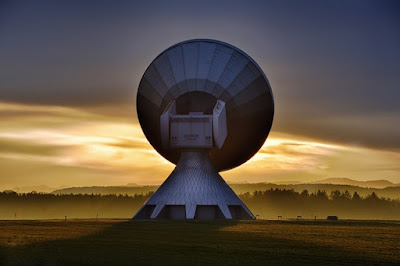Commercial electromagnetic simulation (EM) software packages such as CST Microwave Studio and ANSYS HFSS are widely used in commercial applications and educational purposes. Based on my experience, they provide very accurate results which match measurements in most antenna works. On the other hand, there are also very solid opensource software and applications which may also provide similar results in some applications.
Antennas are also used in radio telescopes
While commercial EM software suits usually have very good documentations, easy-to-use interference, and result visualisation and navigation tools, opensource EM software suits might consist of only the solver and documentation which explains how it should be used and implemented for design and simulation via an interference and a programming language such as Python, MATLAB, C++ . As they are opensource, it is also possible to edit their codes and advance their functions and performance. Thus, these features makes opensource EM software more suitable for research, academic studies and development.
For antenna design and simulation purposes, three opensource software, openEMS, gprMax, FDTD++ are promising as they provide very accurate results, support a wide range of applications and multicore processing (gprMax also supports GPU computation) and very good documentation. Moreover, they are developed by universities and widely used in research and development. An overview of these three software:
openEMS Features
- Efficient EC-FDTD method in full 3D cartesian coordinates (x,y,z)
- Efficient EC-FDTD method in full 3D cylindrical coordinates (ρ, φ, z)
- Fully graded mesh
- Multi-threading, SIMD (SSE) and MPI support for high speed parallel FDTD
- Simple engine extensions API to easily introduce new features to the FDTD algorithm
- Matlab-Interface
- Absorbing boundary conditions (MUR, PML)
- Coordinate dependent material definitions
- Coordinate dependent excitation definitions (e.g. mode-profiles)
- Dispersive material (Drude/Lorentz/Debye type)
- Field dumps in time and frequency domain as vtk or hdf5 file format
- Flexible post-processing routines (mostly in Matlab)
- Subgrids to reduce simulation time in cylindrical coordinates
- Remote simulations using SSH (Linux only)
- PyhOpenEMS: Python support
 |
| OpenEMS can also simulate far-field and radiation patterns, |
- Anisotropic material modelling
- Dispersive material modelling (with multi-pole Debye, Lorenz or Drude formulations)
- Modelling of soils with realistic dielectric and geometric properties
- Building of heterogeneous objects
- Building of objects with rough surfaces
- Built-in libraries of antenna models
Finite-Difference Time-Domain (FDTD) Software in C++
- Fully featured FDTD software, free with open C++ source code
- Developed by active researchers and authors of a number of FDTD methodologies
- Numerical solutions to Maxwell’s equations in 3D, 2D, or 1D
- Solutions in the time and/or frequency domain
- Multiple types of boundary conditions supported
- Advanced features, for greater applicability, accuracy, and computational efficiency, relative to most other FDTD software
- Powerful and flexible geometric modelling capabilities, with support for computer-aided designs, meshes, and algorithmic specifications
- Sophisticated material models, with the most accurate and physically meaningful fits to experimental optical data
- Advanced data processing/post-processing tools
- Powerful, yet simple user interface, with full control over all simulation parameters
- Scalable, from desktop to massively parallel simulations
- Detailed instruction manual, with illustrative examples and tutorials on both FDTD++ and the FDTD methodology
Moreover, in the following websites, you can find more opensource software for EM and general academic purposes.
http://emlab.utep.edu/opensource.htm
There are also a few research papers on opensource antenna design and simulations and comparison with commercial software/applications and measurements:
[1] A. Fedeli, C. Montecucco, and G. L. Gragnani, “Open-source software for electromagnetic scattering simulation: The case of antenna design,” Electron., vol. 8, no. 12, pp. 1–31, 2019, doi: 10.3390/electronics8121506.
[2] C. Warren and A. Giannopoulos, “Creating finite-difference time-domain models of commercial ground-penetrating radar antennas using Taguchi’s optimization method,” Geophysics, vol. 76, no. 2, 2011, doi: 10.1190/1.3548506.
[3] I. Giannakis, A. Giannopoulos, and C. Warren, “Realistic FDTD GPR Antenna Models Optimized Using a Novel Linear/Nonlinear Full-Waveform Inversion,” IEEE Trans. Geosci. Remote Sens., vol. 57, no. 3, pp. 1768–1778, 2019, doi: 10.1109/TGRS.2018.2869027.
[4] C. Warren and A. Giannopoulos, “Experimental and Modeled Performance of a Ground Penetrating Radar Antenna in Lossy Dielectrics,” IEEE J. Sel. Top. Appl. Earth Obs. Remote Sens., vol. 9, no. 1, pp. 29–36, 2016, doi: 10.1109/JSTARS.2015.2430933.
Note: This website will be updated with more information and simulation results soon.

Comments
Post a Comment